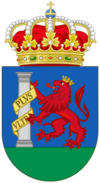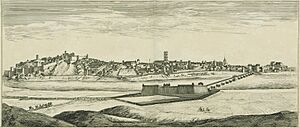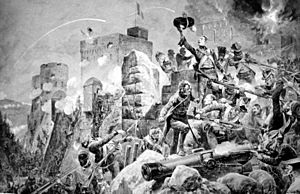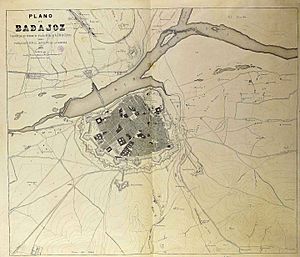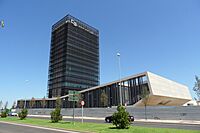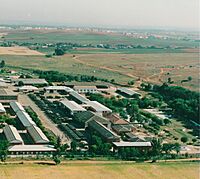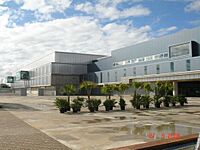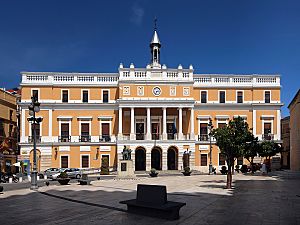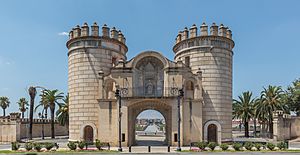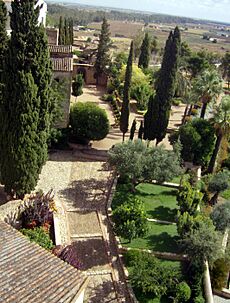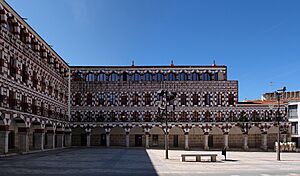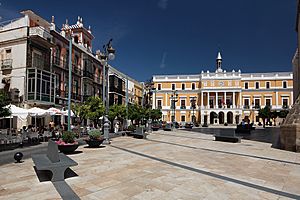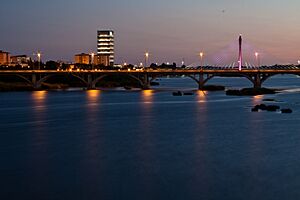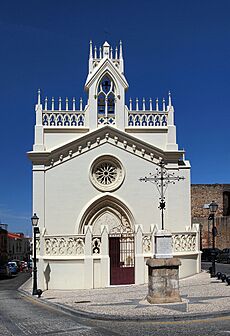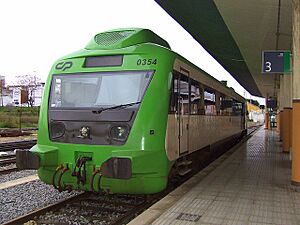Badajoz facts for kids
Quick facts for kids
Badajoz
|
|||
|---|---|---|---|
|
Panoramic view
Alcazaba
Puerta de Palmas
Plaza Alta
City Hall
|
|||
|
|||
| Country | |||
| Autonomous Community | |||
| Province | Badajoz | ||
| Comarca | Tierra de Badajoz | ||
| Founded | c. 875 | ||
| Founded by | Ibn Marwan (over a previous Visigothic settlement) | ||
| Area | |||
| • Total | 1,470 km2 (570 sq mi) | ||
| Elevation
(AMSL)
|
185 m (607 ft) | ||
| Population
(2018)
|
|||
| • Total | 150,530 | ||
| • Rank | 302 | ||
| • Density | 102.4/km2 (265.2/sq mi) | ||
| Time zone | UTC+1 (CET) | ||
| • Summer (DST) | UTC+2 (CEST (GMT +2)) | ||
| Postal code |
70862
|
||
| Area code(s) | +34 (Spain) + 924 (Badajoz) | ||
Badajoz is a city in Extremadura, a region in Spain. It's the capital of the Province of Badajoz. The city is located very close to the Portuguese border, right by the Guadiana River. In 2011, about 151,565 people lived there.
Badajoz has a long and interesting history. It was taken over by the Moors in the 8th century and was later called Baṭalyaws. In the 11th century, it became the capital of its own Moorish kingdom. After the Reconquista (when Christian kingdoms took back Spain), the city was often fought over by Spain and Portugal. This led to many wars, like the War of the Spanish Succession and the Peninsular War. The city's history is truly a reflection of Spain's past.
Today, Badajoz is an important city. It's home to the main church for the Roman Catholic Archdiocese of Mérida-Badajoz. You can see the ruins of the old Moorish castle, the Alcazaba of Badajoz, which looks over the Guadiana River. Even the Badajoz Cathedral, built in 1238, looks like a strong fortress. The city has its own Badajoz Railway Station and Badajoz Airport.
Contents
History of Badajoz
Badajoz has a rich past, with many different groups of people living there over thousands of years.
Ancient Times in Badajoz
Archaeologists have found ancient items in Badajoz from the Bronze Age, which was around 4000 BC. These include old tombs, stone slabs, weapons like axes and swords, and everyday pottery. There are also signs of people living here even earlier, during the Lower Paleolithic period.
When the Romans arrived in 218 BC, Badajoz became part of their large territory called Hispania Ulterior. Later, it was part of Lusitania. Even though Roman history doesn't mention the settlement much, Roman villas have been found nearby. Buildings from the Visigoths have also been discovered.
Founding and the Middle Ages
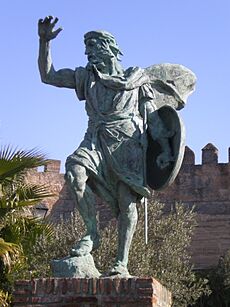
Badajoz became important under Moorish rulers. The city was officially founded around 875 by a nobleman named Ibn Marwan. He had been forced to leave Mérida. Under Ibn Marwan, Badajoz was a strong, independent state.
In the early 11th century, it became the capital of a small Muslim kingdom called the Taifa of Badajoz. At that time, it had about 25,000 people. The city was known as Baṭalyaws during Muslim rule, which is where its current name comes from. Christian rulers took over Badajoz in 1230, led by Alfonso IX of León.
Soon after, a bishopric (a church district) was set up, and work began on the Cathedral of San Juan Bautista. In 1336, the city was attacked by the troops of King Afonso IV of Portugal. However, Spanish-Leonese troops defeated them, and the Portuguese king left the city.
A Jewish community also lived in Badajoz from the 11th century until 1492. The first hospital in the city was started in 1485. In the 16th century, Badajoz saw a burst of culture. Famous people like the painter Luis de Morales and the playwright Diego Sánchez de Badajoz lived there.
In 1524, important leaders from Spain and Portugal met in Badajoz. They discussed their land agreements. In 1580, King Philip II of Spain briefly moved his court to Badajoz. The city thrived from 1580 to 1640 because there were no wars. Many people from Badajoz also helped with the Spanish conquest of the Americas.
Wars and Sieges (1660–1811)
The fight for control of Badajoz and its fortress continued. The Portuguese attacked in 1660. In 1705, during the Spanish War of Succession, the city was taken by the Allies. Later, Spain regained control.
In 1715, Portugal and Spain signed a peace agreement. Portugal gave up its claims to Badajoz. The Peace Treaty of Badajoz was signed in 1801. Portugal agreed to give Olivenza to Spain and close its ports to British ships. This agreement was later broken.
During the Peninsular War, the French attacked Badajoz in 1808 and 1809 but failed. However, in 1811, a Spanish commander surrendered the city to French forces. British and Portuguese armies tried to take it back but had to give up the siege.
The Storming of Badajoz (1812)
In 1812, Arthur Wellesley (who later became the Duke of Wellington) tried again to capture Badajoz. The city had about 5,000 French soldiers defending it. The siege began on March 16.
On April 6, British divisions attacked the city walls. It was a very difficult battle, and many soldiers were lost. After five hours, the main attack failed. However, other parts of the city were attacked, and the British successfully took control. After the city was captured, there was a period of disorder. It took three days to restore order.
This event is remembered each year on April 6. Red jackets are flown on flag staffs at Nottingham Castle. In 1833, Badajoz was described as a "rich and beautiful town."
Spanish Civil War
The Spanish Civil War in the 1930s was a very difficult time for Badajoz. During the war, the city was taken by Nationalist forces in the Battle of Badajoz. After the battle, many people were taken to the city's bullring. There, a terrible event occurred where many lives were lost.
It is estimated that thousands of people died during this time. Even those who tried to escape to Portugal were sent back to Badajoz. The troops involved were led by General Juan Yagüe. He was later known as the "Butcher of Badajoz" because of these events.
Modern History
After the war, Badajoz continued to grow. However, since the 1960s, many people have moved to other parts of Spain or other European countries. Today, Badajoz is a major business center in southwestern Spain. It is an important link between Spain and Portugal for trade and culture.
On November 6, 1997, a severe flood hit the city. It caused the deaths of 21 people and damaged many homes. The flood happened because two usually dry streams, the Rivilla and Calamon, overflowed. The neighborhood of Cerro de Reyes was hit the hardest.
Geography of Badajoz
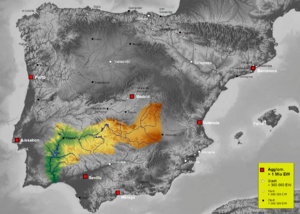
Badajoz is in the southwest of the Iberian Peninsula. It sits on the bank of the Guadiana River, right on the border with Portugal. It is the capital city of the province with the same name.
The city is about 61 kilometers (38 miles) from Mérida. It is 227 kilometers (141 miles) east of Lisbon and 406 kilometers (252 miles) from Madrid. The newer parts of the city are on the left side of the river. This area includes industrial zones and the university hospital.
Badajoz was built on a limestone hill next to the Guadiana River. The Alcazaba fortress is on this hill. The city's average height is 184 meters (604 feet) above sea level. The highest points are Cerro del Viento (219 meters/719 feet) and Fuerte San Cristóbal (218 meters/715 feet). The lowest point is the Guadiana River (168 meters/551 feet).
Climate in Badajoz
Badajoz has a hot-summer Mediterranean climate. This means it has mild winters and very hot summers. Temperatures can sometimes reach 40 °C (104 °F) or more. The climate changes a lot between summer and winter.
The average yearly temperature is 17.4 °C (63.3 °F). The average high in July is 35.1 °C (95.2 °F). The coldest average low in January is 3.7 °C (38.7 °F). The city gets about 435.7 mm (17.15 inches) of rain each year. December is the wettest month, and July is the driest. Badajoz enjoys about 2,860 hours of sunshine every year.
People of Badajoz (Demographics)
In 2010, Badajoz had 150,376 people living there. There were slightly more women (51.4%) than men (48.6%).
Even though Badajoz is the most populated city in Extremadura, it doesn't have a very high population density. This is because its municipality (the area it covers) is very large. It is one of the largest in Spain, covering 1,470 square kilometers (568 square miles). The population includes smaller towns and neighborhoods outside the main city center.

- Source: INE
Note: The increase shown in 2001 was reduced because of the independence of the municipalities of Valdelacalzada and Pueblonuevo del Guadiana in 1993.
City Life and Government
Badajoz is an important center for government in its province. Many local and regional government buildings are located here. The city is part of a large electoral district for the Spanish Congress.
Neighborhoods of Badajoz
Badajoz has many different neighborhoods, each with its own character. Some of them include:
|
|
|
|
Districts of Badajoz
The municipality of Badajoz also includes several smaller districts or towns.
| Name | Type | Population |
|---|---|---|
| Alcazaba | District | 254 |
| Alvarado | District | 389 |
| Balboa | District | 532 |
| Gévora | District | 2308 |
| Guadiana del Caudillo | Gained independence on 17 February 2012 | 2543 |
| Novelda del Guadiana | District | 909 |
| Sagrajas | District | 631 |
| Valdebótoa | District | 1.294 |
| Villafranco del Guadiana | District | 1.544 |
| TOTAL PEDANÍAS | 7861 |
Economy of Badajoz
In the past, wars made the economy of Badajoz struggle. The land wasn't very fertile, and there wasn't much industry. However, the city's historic buildings and those in nearby Mérida attract many visitors. This has helped tourism grow. In recent years, some new industries have also developed.
Today, Badajoz is mainly a commercial city. It's ranked as one of the most important economic cities in Spain. Because it's so close to Portugal, it has a lot of trade with its neighbor. The service sector (like shops and businesses) is very important here.
Menacho is the main shopping street. Many national and international stores are located there. The Centro Comercial Abierto Menacho is a large outdoor shopping area. Thousands of Portuguese visitors come here each year to shop.
Badajoz also has industries that make things like linen, wool, leather goods, and pottery. To help with trade, a new trade fair center called Institución Ferial de Badajoz (IFEBA) was built in 2006. This center hosts many different markets and events.
The city's industrial area, El Nevero, is growing. It has many different companies. In 2007, plans were made for a new headquarters for Caja de Badajoz. This building, the Torre Caja Badajoz, is 88 meters (289 feet) tall. It is now the tallest building in Extremadura. Badajoz also has an airport and a conference center.
Famous Places in Badajoz
Badajoz is full of buildings from Moorish and medieval times. While there are some Roman and Visigothic remains, they are not as visible as in Mérida.
The Alcazaba fortress is the most famous building. It shows the Moorish history of Badajoz. This fortress was very important for defending the border with Portugal. It also controlled trade routes. Today, it is the Archaeological Museum of Badajoz. Many old monuments in Badajoz have been repaired. The city's restaurants and nightlife also attract many Portuguese visitors.
The 13th-century Badajoz Cathedral was once a mosque. Its strong walls show the city's turbulent history. Three of its windows are special: one is Gothic, one is Renaissance, and one is Plateresque.
City Buildings
The Palacio de Congresos de Badajoz is the city's congressional palace. The Palacio Municipal houses the City Hall. The current City Hall building was built in 1852. It was renovated in 1937, with new towers and decorations. It has a balustrade, a central balcony, and columns.
Badajoz has several public libraries. These include the Biblioteca Pública Municipal A. Dominguez and the Biblioteca Pública Municipal Pardaleras.
Historical Sites
The Alcazaba Fortress
The Alcazaba is a Moorish citadel (a strong castle). It was built in the 9th century by Ibn Marwan. It was made even stronger in 1169. The Alcazaba was the home of the rulers of the Taifa of Badajoz in the 11th and 12th centuries. Christian rulers took it over in the 13th century.
The Torre de Espantaperros is a tower that is 30 meters (98 feet) tall. It was built with mud and mortar. It used to have a bell that made a loud ringing sound. A building next to it, called La Galera, was once the city hall and then a prison. Now, it is the Archaeological Museum. This area also has a garden with archaeological finds from different periods.
Vauban Fort
This military fort was built in the 17th century. It was a defense during a war between Spain and Portugal. It is made of stone, brick, and concrete. It has eight strong bastions (parts of a fort that stick out). These bastions protected the northern part of the fort. The Guadiana and Rivilla rivers protected the south.
La Giralda
La Giralda is a building near Plaza de la Soledad. It looks like a famous tower in Sevilla called the Giralda. This building was finished in 1930 by a local businessman. It was built in a style that looks like old Arab buildings. It has ceramic tiles and metal work.
In 1978, a company called Telefónica bought the building and used it for offices. They later moved out. There have been ideas to use the building for a museum or a cultural center.
Puerta de Palmas
The Puerta de Palmas is a historic gate built in 1551. It has two round towers on either side of the entrance. The names of Prince Philip II and Emperor Charles V are on the outside of the tower. The towers have battlements (notches for defense) and decorations. The gate faces east and has two arches. It was once used as a prison. Now, it is an important entrance to the city.
Real Monasterio de Santa Ana
This is a Christian monastery in Badajoz. It was declared a special cultural site in 1988. It is the home of the Order of St. Clare in the city. The monastery was founded in 1518. It was greatly changed in the 18th century, but some of the original building remains. The church inside has many altarpieces, paintings, and silver items.
Gardens in Badajoz
The Jardines de la Galera (Gardens of La Galera) date back to the 10th century. They are located between the Torre de Espantaperros and the old city walls, inside the Alcazaba. Many old ruins are still in the gardens. They have been open to the public since 2007 after being restored. The gardens were once a place for prisoners to rest. You can find many types of plants and trees here, like myrtle, laurel, orange, lemon, and pomegranate trees.
Other parks and gardens in the city include Castelar, which has a pond and monuments. The city also has a water and leisure park called Lusiberia.
Museums in Badajoz
Badajoz has several interesting museums:
- The Museo Extremeño e Iberoamericano de Arte Contemporáneo (MEIAC) has art from Spanish, Portuguese, and Latin American artists. It is built on the site of an old prison.
- The Museo Provincial de Bellas Artes (Provincial Museum of Fine Arts) is the main art gallery in Extremadura. It is located in two old 19th-century houses. It has over 1,200 paintings and sculptures from the 16th to the 20th century. You can see works by famous artists like Luis de Morales and Francisco de Goya.
- The Museo de la Ciudad "Luis de Morales" ("Luis de Morales" City Museum) might have been the home of the Renaissance painter Luis de Morales. It displays many of his paintings.
- The Museo Arqueológico Provincial (Provincial Archaeological Museum) is inside the fortress. It has items from all over the Province of Badajoz. The building itself is a beautiful 16th-century palace.
- The Museo Catedralicio (Cathedral Museum) is at the cathedral. It shows the history of the building and the church. It has old carvings, tapestries, and works by Luis de Morales.
- The Museo Taurino (Bullfighting Museum) is in the city center. It has posters, photos, and items related to bullfighting.
- The Museo del Carnaval (Carnival Museum) opened in 2007. It displays costumes from the city's carnival celebrations.
Plazas (Squares)
- Plaza de España is in the center of the city. It was designed in 1917. The large cathedral is located here.
- Plaza de Cervantes is important for Badajoz's history. Part of it used to be a church and cemetery. It has white marble and a mosaic design.
- Plaza Alta has been recently restored. For centuries, it was the main square of the city. The famous Spanish flamenco guitarist Paco de Lucía performed here in 2013.
- La Giralda building is near Plaza de la Soledad.
Residential Buildings
- Casa Álvarez-Buiza is a private house and business complex. It was built between 1918 and 1912. It uses lime, brick, and colorful ceramics.
- Casa del Cordón is a private house built in the early 16th century. It has unique windows. It now houses the Archdiocese.
- Casa Puebla, built in 1921, is a good example of regional architecture. It has two facades, with the main one showing Renaissance elements.
Cemeteries
In ancient times, people were buried near sites like Picuriña and Cerro de Reyes. During the Arab period, burials were along roads and near the Citadel. For centuries, Christians in Badajoz buried their dead in or near churches.
Badajoz's oldest cemeteries still in use are Cementerio de San Juan and Cementerio de Nuestra Señora de la Soledad.
Bridges of Badajoz
Badajoz has five bridges, and four of them cross the Guadiana River.
- The Puente de Palmas, also called Puente Viejo (Old Bridge), is the oldest bridge. It was first started in 1460. Floods destroyed parts of it several times, and it was rebuilt. It was last rebuilt in 1833. It is now 600 meters (1,969 feet) long with 32 spans. The bridge shows the city's history through its many changes.
- Puente de la Universidad, or Puente Nuevo (New Bridge), was built in 1960.
- Puente de la Autonomía Extremeña was finished in 1990. It connects to major roads leading to Madrid and Portugal.
- Puente Real is a suspension bridge built in 1994. The King of Spain laid its foundation stone in 1992. It is 452 meters (1,483 feet) long. It has a bicycle lane and connects to Portugal.
Culture and Education
Badajoz has been the birthplace of many famous artists, musicians, and writers. These include actors like Luis Alcoriza, writers like Arturo Barea, and singers like Rosa Morena. The Institución Ferial de Badajoz (IFEBA) is a cultural center that hosts many events.
The main theater in Badajoz is the Teatro López de Ayala. It is a large white theater with arched windows and seats about 800 people. It hosts plays, operas, concerts, and exhibitions.
Like much of southern Spain, flamenco music and dance are very popular. Performances are often held in Plaza Alta. The city also has a classical music group, Banda Municipal de Música, founded in 1867. The Municipal School of Music in Badajoz teaches instruments and singing to hundreds of students.
The "Feria de San Juan" festival is held every year from June 23 to July 1. It is a big event for people from Spain and Portugal. This festival also includes bullfights.
Badajoz is influenced by its closeness to Portugal. You can find Portuguese restaurants and pastries in the city. People often travel across the border for meals or trips.
Badajoz is home to the Universidad de Extremadura (UNEX) campus. The university was founded in 1968. It has branches in Badajoz, Cáceres, Mérida, and Plasencia.
Religion in Badajoz

Badajoz is the main city for the Roman Catholic Archdiocese of Mérida-Badajoz. The Badajoz Cathedral (Cathedral of St. John the Baptist) is the main church. It is a gothic style building that was built in 1284. It was renovated many times between the 16th and 18th centuries. Paintings by local artist Luis de Morales are displayed in the cathedral. The cathedral's tower is 41 meters (135 feet) tall. It was built in 1542.
Adoratrices is a small chapel dedicated to St. Joseph. It was built to remember the arrival of Christians with King Alfonso IX. The chapel was damaged during a war in the 19th century. It was rebuilt in 1917 in a neo-Gothic style.
Other religious buildings include the San Andres and La Concepcion churches, which date back to the 13th century. The Ermita de la Soledad is a gothic-style chapel. The Parroquia de San Juan Bautista was originally a Franciscan convent.
Sports and Fun
Football
Badajoz has a strong football (soccer) tradition. The city's main club is CD Badajoz 1905. This club was formed in 2012 by fans of the old CD Badajoz club. They play at the Estadio Nuevo Vivero stadium.
Another football club in Badajoz is Badajoz CF. They also play their home matches at the Estadio Nuevo Vivero.
Basketball
Badajoz used to have a basketball club called AB Pacense. It was formed in 2005. The club played in the Liga EBA. They played their home games at Polideportivo La Granadilla. The club stopped playing in 2013.
Golf
Badajoz has two golf courses:
- The Don Tello Golf Course is a 9-hole course built in 1994. It is described as gentle and rolling, located by the Guadiana River.
- The Guadiana Golf Course is an 18-hole course built in 1992. It is considered challenging because it has 14 water features and many trees.
Getting Around (Transport)
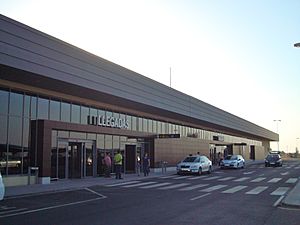
- Badajoz railway station is the city's only train station. It handles long-distance and medium-distance trains. It is the last Spanish train station before the Portuguese railway system. There are plans for a new station with high-speed train services.
- Badajoz Airport is about 13 kilometers (8 miles) east of the city center. It shares a runway with a Spanish Air Force base. The airport currently has flights to Barcelona and Madrid.
Healthcare
The first hospital in Badajoz was the Hospital de San Sebastián, founded in 1694.
Badajoz is part of the Área de Salud de Badajoz healthcare region. This region includes several other towns. The hospitals in Badajoz are Hospital Universitario de Badajoz, Hospital Perpetuo Socorro, and Hospital Materno Infantil. There are also several clinics. The Hospital Universitario de Badajoz is located near the University of Extremadura.
Famous People from Badajoz
Many notable people were born in Badajoz, including:
- Pedro de Alvarado (1485–1541), a famous explorer and conqueror.
- Manuel Godoy (1767–1851), a Spanish statesman.
- Luis de Morales (1509–1586), a well-known painter.
- Rosa Morena (1941–2019), a popular flamenco-pop singer.
- Cristóbal Oudrid (1825–1877), a pianist, conductor, and composer.
- Hernando de Soto (1497–1542), another famous explorer and conqueror.
Sister Cities
Badajoz is twinned with several cities around the world. This means they have special friendly relationships.
See also
 In Spanish: Badajoz para niños
In Spanish: Badajoz para niños








